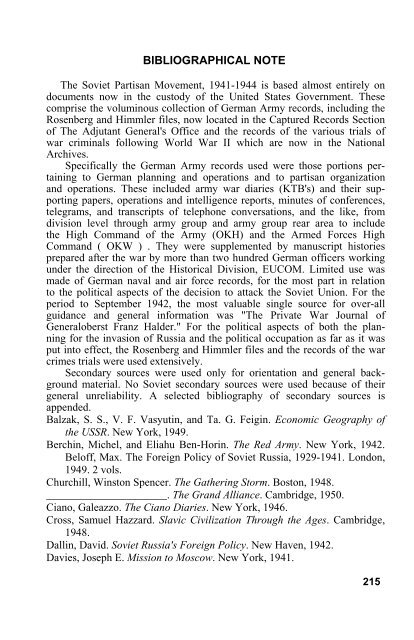the soviet partisan movement 1941-1944 by edgar m. howell
the soviet partisan movement 1941-1944 by edgar m. howell
the soviet partisan movement 1941-1944 by edgar m. howell
Create successful ePaper yourself
Turn your PDF publications into a flip-book with our unique Google optimized e-Paper software.
BIBLIOGRAPHICAL NOTE <br />
The Soviet Partisan Movement, <strong>1941</strong>-<strong>1944</strong> is based almost entirely on<br />
documents now in <strong>the</strong> custody of <strong>the</strong> United States Government. These<br />
comprise <strong>the</strong> voluminous collection of German Army records, including <strong>the</strong><br />
Rosenberg and Himmler files, now located in <strong>the</strong> Captured Records Section<br />
of The Adjutant General's Office and <strong>the</strong> records of <strong>the</strong> various trials of<br />
war criminals following World War II which are now in <strong>the</strong> National<br />
Archives.<br />
Specifically <strong>the</strong> German Army records used were those portions pertaining<br />
to German planning and operations and to <strong>partisan</strong> organization<br />
and operations. These included army war diaries (KTB's) and <strong>the</strong>ir supporting<br />
papers, operations and intelligence reports, minutes of conferences,<br />
telegrams, and transcripts of telephone conversations, and <strong>the</strong> like, from<br />
division level through army group and army group rear area to include<br />
<strong>the</strong> High Command of <strong>the</strong> Army (OKH) and <strong>the</strong> Armed Forces High<br />
Command ( OKW ) . They were supplemented <strong>by</strong> manuscript histories<br />
prepared after <strong>the</strong> war <strong>by</strong> more than two hundred German officers working<br />
under <strong>the</strong> direction of <strong>the</strong> Historical Division, EUCOM. Limited use was<br />
made of German naval and air force records, for <strong>the</strong> most part in relation<br />
to <strong>the</strong> political aspects of <strong>the</strong> decision to attack <strong>the</strong> Soviet Union. For <strong>the</strong><br />
period to September 1942, <strong>the</strong> most valuable single source for over-all<br />
guidance and general information was "The Private War Journal of<br />
Generaloberst Franz Halder." For <strong>the</strong> political aspects of both <strong>the</strong> planning<br />
for <strong>the</strong> invasion of Russia and <strong>the</strong> political occupation as far as it was<br />
put into effect, <strong>the</strong> Rosenberg and Himmler files and <strong>the</strong> records of <strong>the</strong> war<br />
crimes trials were used extensively.<br />
Secondary sources were used only for orientation and general background<br />
material. No Soviet secondary sources were used because of <strong>the</strong>ir<br />
general unreliability. A selected bibliography of secondary sources is<br />
appended.<br />
Balzak, S. S., V. F. Vasyutin, and Ta. G. Feigin. Economic Geography of<br />
<strong>the</strong> USSR. New York, 1949.<br />
Berchin, Michel, and Eliahu Ben-Horin. The Red Army. New York, 1942.<br />
Beloff, Max. The Foreign Policy of Soviet Russia, 1929-<strong>1941</strong>. London,<br />
1949. 2 vols.<br />
Churchill, Winston Spencer. The Ga<strong>the</strong>ring Storm. Boston, 1948.<br />
______________________. The Grand Alliance. Cambridge, 1950.<br />
Ciano, Galeazzo. The Ciano Diaries. New York, 1946.<br />
Cross, Samuel Hazzard. Slavic Civilization Through <strong>the</strong> Ages. Cambridge,<br />
1948.<br />
Dallin, David. Soviet Russia's Foreign Policy. New Haven, 1942.<br />
Davies, Joseph E. Mission to Moscow. New York, <strong>1941</strong>.<br />
215
















